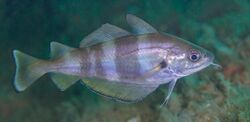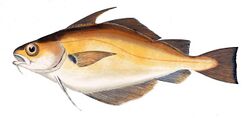Biology:Trisopterus luscus
| Trisopterus luscus | |
|---|---|

| |

| |
| Scientific classification | |
| Domain: | Eukaryota |
| Kingdom: | Animalia |
| Phylum: | Chordata |
| Class: | Actinopterygii |
| Order: | Gadiformes |
| Family: | Gadidae |
| Genus: | Trisopterus |
| Species: | T. luscus
|
| Binomial name | |
| Trisopterus luscus | |
| Synonyms | |
|
Gadus luscus Linnaeus, 1758 | |
Trisopterus luscus (Latin pronunciation: [ˈtrisopterus ˈluskus]; bib, pout whiting, pout or most commonly pouting) is a seafish belonging to the cod family (Gadidae).
Distribution, size and life cycle
Pouting are found predominantly in European waters, especially around the south and west of the British Isles and in Scandinavian waters, although they can also be found in the Mediterranean and along the north African coast.[2] They can be found across rocky and sandy seabeds with smaller specimens being found close to the shore and larger pouting being moving further offshore. The greatest depths at which pouting can be found is 300 metres.[3] Pouting are generally a small fish, seldom exceeding 30 centimetres in length, although rare specimens can reach almost double this length. Pouting can reproduce before they reach two years of age and grow rapidly, reaching around 15 centimetres in length by the end of their first year. Pouting are a relatively short lived species, with the average lifespan thought to be around four years.[4]
Feeding and diet
Pouting are scavengers which feed on the seabed. They forage for any food source they can find with marine worms, shellfish and dead fish all making up their diet.[4] Due to their small size pouting are a source of prey for large species such as cod, bass and conger eels.
Commercial value
Pouting were previously ignored as a commercial fish, with pouting that were inadvertently caught by trawlers being either discarded at sea or processed into fishmeal.[4] Captured pouting are unlikely to survive when discarded.[5] However, the decline in the stocks of whitefish species such as cod and haddock has seen pouting acquire a growing value as a commercial fish,[4] and they are now available both as whole fish from fishmongers and supermarkets and are also used in fish products such as fish fingers and ready meals. Due to their naturally short lifespan and early breeding age pouting are seen as a relatively sustainable fish to eat.[6]
References
- ↑ Di Natale, A.; Molinari, A.; Őztűrk, B.; Srour, A. (2011). "Trisopterus luscus". IUCN Red List of Threatened Species 2011: e.T198587A9042469. https://www.iucnredlist.org/species/198587/9042469.
- ↑ "Trisopterus luscus". FishBase. http://www.fishbase.org/summary/Trisopterus-luscus.html.
- ↑ "Bib or Pouting, Trisopterus luscus". MarLIN - The Marine Life Information Network. http://www.marlin.ac.uk/speciesinformation.php?speciesID=4506.
- ↑ 4.0 4.1 4.2 4.3 "Pouting". British Sea Fishing. September 2012. http://britishseafishing.co.uk/pouting/.
- ↑ Depestele, J.; Desender, M.; Benoît, H. P.; Polet, H.; Vincx, M. (2014). "Short-term survival of discarded target fish and non-target invertebrate species in the "eurocutter" beam trawl fishery of the southern North Sea". Fisheries Research 154: 82–92. doi:10.1016/j.fishres.2014.01.018.
- ↑ "Pouting or Bib". Good Fish Guide. Marine Conservation Society. http://www.fishonline.org/fish/pouting-or-bib-88.
External links
Wikidata ☰ Q599799 entry
 |


